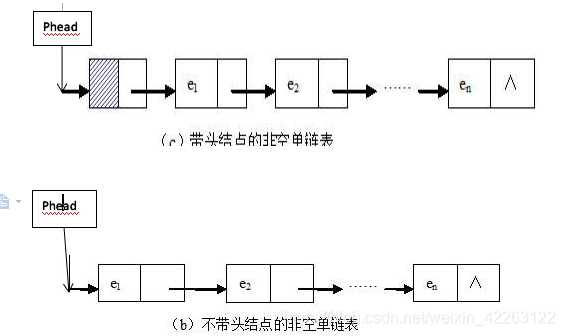
typedef int DataType;
typedef struct SListNode{//结点
struct SListNode* next;
DataType data;
}SListNode,*PListNode;
int main(){
PListNode Phead;
}
区别:
(1)尾插操作:因为如果链表为空,无头链表需要对头指针Phead进行赋值所以传参时,需要传PlistNode* 类型的数据,而头指针只需要传递PListNode类型的数据。而且无头链表尾插时更加麻烦因为如果是空链表需要改变的是phead 的值。代码如下:(BuyNewNode操作见详细代码)
无头:
void SListPushBack(PListNode* Phead, DataType data){//尾插
assert(Phead);
if(*Phead == NULL){
(*Phead) = BuyNewNode(data);
}else{
PListNode ptr = (*Phead);
while(ptr ->next){//找到链表最后一个元素
ptr = ptr ->next;
}
ptr ->next = BuyNewNode(data);
}
}
有头:
void SListPushBack(PListNode Phead, DataType data){//尾插
assert(Phead);
while(Phead ->next){//找到最后一个元素
Phead = Phead ->next;
}
Phead ->next = BuyNewNode(data);
}
(2)尾删操作 :两者的区别与尾插操作类似 :如果链表只有一个元素 无头链表需要改变(Phead)的值。而有头结点却不需要。所以有头结点更加方便 代码见(代码详情)
(3)头插 头删: 显而易见 无头结点链表需要传入 PListNode 而 有头结点需要传入 PListNode,两个操作都同样简单,只不过 无头结点链表 在Phead处做操作,有头结点,在头结点的next处做操作。
详细代码:
有头结点:
#include<stdio.h>
#include<assert.h>
#include<stdlib.h>
//有头单链表的实现;
typedef int DataType;
typedef struct SListNode{// 结构体SListNode用来描述:无头单链表的每个节点(节点的数据 ,下一个节点的地址);
struct SListNode* next;
DataType data;
}SListNode,*PListNode;
void SListInit(PListNode* list){// 链表初始化
*list = (PListNode)malloc(sizeof(SListNode));//头结点
(*list) ->next = NULL;
}
PListNode BuyNewNode(DataType data){//创建一个新节点
PListNode PNode = (PListNode)malloc(sizeof(SListNode));
if(PNode){//申请成功
PNode ->data = data;
PNode ->next = NULL;
return PNode;
}else{
printf("BuyNewNode failed\n");
return NULL;
}
}
void PrintfList(PListNode Phead){//打印链表
assert(Phead);
PListNode ptr = Phead ->next;
if(ptr == NULL){
printf("这是一个空链表");
}else{
while(ptr){
printf("%d->",ptr ->data);
ptr = ptr ->next;
}
printf("\n");
}
}
void SListPushBack(PListNode Phead, DataType data){//尾插
assert(Phead);
while(Phead ->next){//找到最后一个元素
Phead = Phead ->next;
}
Phead ->next = BuyNewNode(data);
}
void SListPopBack(PListNode Phead){//尾删
assert(Phead);
PListNode ptr = Phead;
PListNode bptr = NULL;
while(ptr ->next){
bptr = ptr;
ptr = ptr ->next;
}
if(bptr){
bptr ->next = NULL;
free(ptr);
}else{//链表为空
printf("没有元素可以删除了");
}
}
void SListPushFront(PListNode Phead, DataType data){// 头插
assert(Phead);
PListNode ptr = BuyNewNode(data);
ptr ->next = Phead ->next;
Phead ->next = ptr;
}
void SListPopFront(PListNode Phead){//头删
assert(Phead);
if(Phead ->next){
PListNode ptr = Phead ->next;
Phead ->next = ptr ->next;
free(ptr);
}else{
printf("没有可以删除的元素");
}
}
PListNode ListFind(PListNode Phead, DataType data){//查找data
PListNode ptr = Phead ->next;
while(ptr){// 如果是空链表不执行循环,返回NULL;
if (ptr ->data == data){
break;
}
ptr = ptr ->next;
}
return ptr;
}
bool ListInsert(PListNode Phead, PListNode pos, DataType data){//在pos位置插入 data
if(Phead == NULL || Phead ->next == NULL){//链表为空
return false;
}
PListNode ptr = Phead ->next;
PListNode bptr = Phead;
while(ptr){ //为空代表 没有找到pos
if(ptr == pos){
bptr ->next = BuyNewNode(data);
bptr = bptr ->next;
bptr ->next = ptr;
break;
}
bptr = ptr;
ptr = ptr ->next;
}
if(ptr == NULL){//没有找到pos 位置
return false;
}else{//插入成功
return true;
}
}
bool ListErase(PListNode Phead, PListNode pos){//删除pos位置的节点
if(Phead == NULL || Phead ->next ==NULL){
return false;
}
PListNode ptr = Phead ->next;
PListNode bptr = Phead;
while(ptr){
if(ptr == pos){
bptr ->next = ptr ->next;
free(ptr);
break;
}else{
bptr = ptr;
ptr =ptr ->next;
}
}
if(ptr == NULL){
return false;
}else{
return true;
}
}
void ListDestroy(PListNode* Phead){//删除链表
assert(Phead);
if((*Phead) == NULL){
return ;
}
PListNode ptr = *Phead;
PListNode pdestory = ptr;
while(ptr){
ptr = ptr ->next;
free(pdestory);
pdestory = ptr;
}
*Phead = NULL; //如果忘记*Phead 会变成野指针
}
int main(){
PListNode Phead;
system("pause");
}
无头结点:
#include<stdio.h>
#include<assert.h>
#include<stdlib.h>
//无头单链表的实现;
typedef int DataType;
typedef struct SListNode{//结点
struct SListNode* next;
DataType data;
}SListNode,*PListNode;
void SListInit(PListNode* Phead){// 链表初始化
(*Phead) = NULL;
}
PListNode BuyNewNode(DataType data){//创建一个新节点
PListNode PNode = (PListNode)malloc(sizeof(SListNode));
if(PNode){//申请成功
PNode ->data = data;
PNode ->next = NULL;
return PNode;
}else{
printf("BuyNewNode failed\n");
return NULL;
}
}
void PrintfList(PListNode Phead){//打印链表
if(Phead == NULL){
printf("这是空链表");
}else{
PListNode ptr = Phead;
while(ptr){
printf("%d->",ptr ->data);
ptr = ptr ->next;
}
printf("\n");
}
}
void SListPushBack(PListNode* Phead, DataType data){//尾插
assert(Phead);
if(*Phead == NULL){
(*Phead) = BuyNewNode(data);
}else{
PListNode ptr = (*Phead);
while(ptr ->next){//找到链表最后一个元素
ptr = ptr ->next;
}
ptr ->next = BuyNewNode(data);
}
}
void SListPopBack(PListNode* Phead){//尾删
assert(Phead);
if((*Phead) == NULL){
printf("没有元素可以删除了");
}else{//链表至少有一个节点
PListNode ptr = *Phead;
PListNode bptr = NULL;//bptr的初始值为第零个节点
while(ptr ->next){// 使得 ptr指向最后一个结点 bptr 为倒数第二个节点
bptr = ptr;
ptr = ptr ->next;
}
if(bptr){//链表至少有两个元素(改变 bptr ->next)
bptr ->next =NULL;
free(ptr);
}else{//链表只有一个元素(改变(*Phead))
(*Phead) = NULL;
free(ptr);
}
}
}
void SListPushFront(PListNode* Phead, DataType data){// 头插
assert(Phead);
PListNode ptr = BuyNewNode(data);
ptr ->next = (*Phead);
(*Phead) = ptr;
}
void SListPopFront(PListNode* Phead){//头删
assert(Phead);
if(*Phead){//至少有一个元素
PListNode ptr = (*Phead);
(*Phead) = ptr ->next;
free(ptr);
}else{
printf("没有可以删除的元素");
}
}
PListNode ListFind(PListNode Phead, DataType data){//查找data
PListNode ptr = Phead;
while(ptr){// 如果是空链表不执行循环,返回NULL;
if (ptr ->data == data){
break;
}
ptr = ptr ->next;
}
return ptr;
}
bool ListInsert(PListNode* Phead, PListNode pos, DataType data){//在pos位置插入 data
if((*Phead) == NULL || Phead == NULL){//链表为空
return false;
}
PListNode ptr = *Phead;
PListNode bptr = ptr;
if(ptr == pos){//插入链表的第一个位置 需要改变(*Phead)
(*Phead) = BuyNewNode(data);
(*Phead) ->next = ptr;
}else{
ptr = ptr ->next;
while(ptr){ //为空代表 没有找到pos
if(ptr == pos){
bptr ->next = BuyNewNode(data);
bptr = bptr ->next;
bptr ->next = ptr;
break;
}
bptr = ptr;
ptr = ptr ->next;
}
}
if(ptr == NULL){//没有找到pos 位置
return false;
}else{//插入成功
return true;
}
}
bool ListErase(PListNode* Phead, PListNode pos){//删除pos位置的节点
assert(Phead);
if(*Phead == NULL){
return false;
}
PListNode ptr = *Phead;
PListNode bptr = ptr;
if(ptr == pos){//如果是删除链表的第一个节点
*Phead = ptr ->next;
free(ptr);
}else{//
while(ptr){
if(ptr == pos){
bptr ->next = ptr ->next;
free(ptr);
break;
}else{
bptr = ptr;
ptr =ptr ->next;
}
}
}
if(ptr ==NULL){
return false;
}else{
return true;
}
}
void ListDestroy(PListNode* Phead){//删除链表
if(Phead == NULL|| (*Phead) == NULL){
return ;
}
PListNode ptr = *Phead;
PListNode pdestory = ptr;
while(ptr){
ptr = ptr ->next;
free(pdestory);
pdestory = ptr;
}
*Phead = NULL; //如果忘记*Phead 会变成野指针
}
int main(){
PListNode Phead;
system("pause");
}





















 295
295











 被折叠的 条评论
为什么被折叠?
被折叠的 条评论
为什么被折叠?








